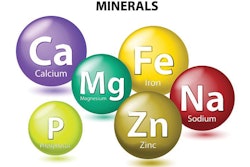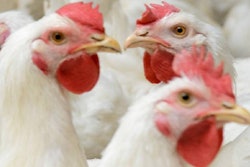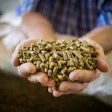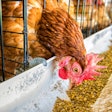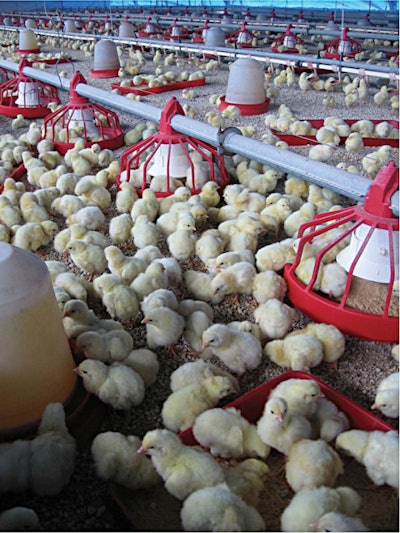
Broiler breeder management is an exciting challenge, but there are many variables that contribute to consistent flock performance. When assessing egg production, most people focus on body weight and body weight gains and compare this to a standard body weight curve. This is an ineffective technique because pullet body weight is a crude indicator of subsequent hen performance. Therefore, more variables must be considered when assessing these breeders.
By virtue of its genetic makeup, a broiler has a voracious appetite and matching capacity to convert this feed into weight gain. This efficiency is partially transferred to the breeder, which means we must focus on our management processes to get the required fat reserves for reproduction without putting on too much muscle.
The reproductive potential of these birds is high, with 150 to 160 chicks per hen placed. To achieve these results, uniformity is crucial. The most critical and difficult part of managing a broiler breeder flock is to achieve and to maintain the ideal body weight with the right proportion of skeleton, muscles and fat for any given age. Any significant deviation during the growing and laying cycles can lead to poor performance.
Starter period recommendations
The period from hatch to four weeks is important in determining future performance. Nutrition must focus on the proper development of skeletal, intestinal, cardiovascular and immune systems.
If the birds have good development at this early stage, they will present good uniformity later on. Limits on crude protein and amino acid intake are crucial; increased crude protein intake will improve flock uniformity, but also increase body weight. Heavy body weight early on will require a higher degree of feed restriction later.
Feeding a starter diet is sufficient to support appropriate body weight gains so that females are on target weight at four weeks of age.
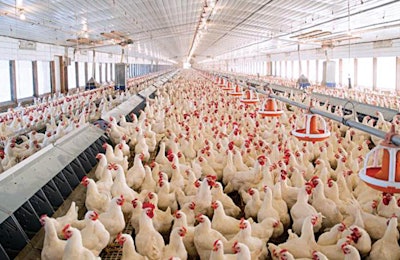
Breeders ingest almost 11 percent less food to produce a dozen eggs than they did 20 years ago. | Cobb-Vantress
Feed conversion during grower period
The selection of broilers to improve feed conversion has a similar effect on breeders. Every year, females (hens) and males (roosters) show better feed conversion.
In the past 20 years, the breeders have improved egg production capability and efficiency and they now ingest almost 11 percent less food to produce a dozen eggs. Grower diets are usually formulated with a protein (digestible lysine) and energy level in the range of 14-15.5 percent (protein), 0.50-0.60 percent (digestible lysine) and 2,575-2,865 ME/Kcal (metabolizable energy).
However, it is usually more difficult to achieve good flock uniformity with higher dietary energy because a smaller amount of feed is needed to meet the energy requirement of the bird, and feed clean-up times are shorter. The protein (amino acids) to energy ratio must be maintained to avoid excess protein (amino acids) intake and, subsequently, changes in weight gain composition (protein), which could result in overfleshed birds.
Light stimulation in pre-breeders
For broiler breeders to achieve their full reproductive potential, they must receive the correct nutrition, with particular attention on feeding during pre- and post-peak.
The priority is to ensure that the female receives enough nutrients for body weight, maintenance, growth and egg production, through adequate daily energy while also maintaining the correct intake of protein (amino acids), vitamins and minerals.
Assuming that birds are continually producing yolk precursors within a follicular hierarchy, the feed allocation from onset of lay to peak production is the key point for maintaining weight gain, achieving standard egg size and avoiding metabolic disorders.
Increased nutrient consumption at the wrong time will elevate mortality and reduce peak egg production, thus affecting overall production. Peak egg production determines overall flock performance 75 percent of the time. If a flock peaks poorly, it has a 75 percent chance of producing poorly.
For every 1 percent increase in peak production, approximately 1.6 additional total eggs per hen housed will be obtained.
The intake of energy from light stimulation to the first egg can have a dramatic effect on survivability and subsequent egg production. Aggressively feeding a flock that’s not ready for light stimulation will negatively affect flock performance. After light stimulation, controlling nutrient intake is the primary driver defining bird health.
Energy requirements in production phase
Today’s breeder diets tend to oversupply all nutrients except for energy that can be metabolized; therefore, energy is the limiting nutrient. Energy must be elevated during the climb to peak egg production, but high body weight coupled with increased egg production will elevate mortality and lower egg production.
The amount of energy supplied to the hen can exceed their oxidative capacity of converting feed energy into tissue and egg mass, increasing stress and mortality.
The hen’s lean mass content (fleshing) is a critical component of well-being. Between light stimulation and 5 percent egg production, energy intake is negatively correlated with survivability. Assuming the correct muscle mass is achieved at light stimulation; hens need relatively low energy increases during this period. This is not the right time to try to correct an error associated with improper pullet management.
For example, for Cobb hens laying a 60-gram egg, the energy needed is 127 Kcal. As egg production and egg size increases, it is logical to assume that the energy needs of the flock increase. The current daily energy recommendation at peak for broiler breeder hens is approximately 440-460 Kcal.
Craig Coon, poultry nutritionist at the University of Arkansas, recommends a daily protein intake of 19.35 grams/bird/day for egg production. The excess of some amino acids, i.e. lysine and isoleucine, and protein can be harmful to hatchability. The use of diets with higher protein for extended periods may make controlling body weight difficult and often results in overweight birds and increased egg size.
The hatchability of eggs heavier than 65 grams is reduced. An energy requirement of 440-460 Kcal/bird/day at peak with an expected consumption of 23-24 grams of protein/bird/day will result in excellent egg production peaks and good early egg size.
At the end of the production cycle, the birds should not ingest more than 400 Kcal/bird/day and 19-20 gram of protein/bird/day.
Proper nutrition at critical production points
Following the recommended nutrition advice for the selected line of broiler breeder will help to achieve target body weights and reproductive performance. Special attention must be paid to protein and energy allowances in the production phase and feed allocation must ensure nutritional needs are adequately met, with energy intake being the primary factor in success.
To improve early chick quality and maintain late hatchability, feeding pre- and post-peak must be carefully monitored, taking into account egg production, body weight, egg size, fat reserves and feather cover. Any changes to feed consumption must also consider the effect it would have on nutrient intake if birds are to avoid being over- or under-fed.


